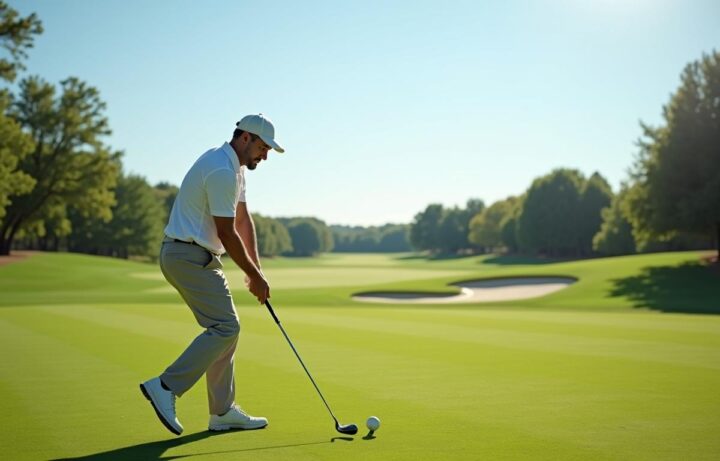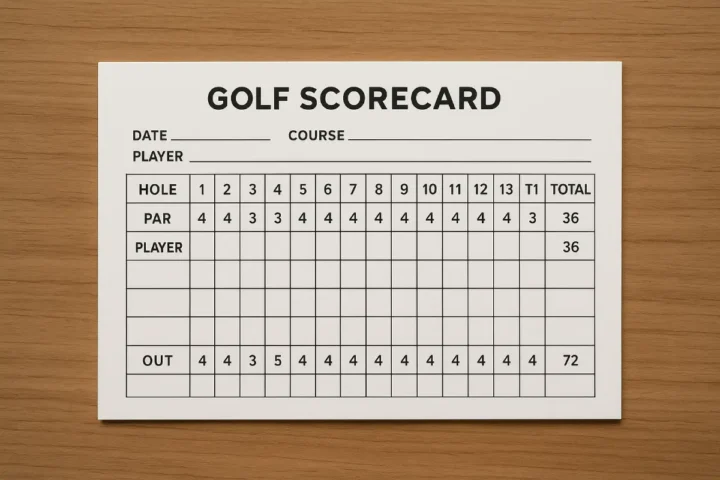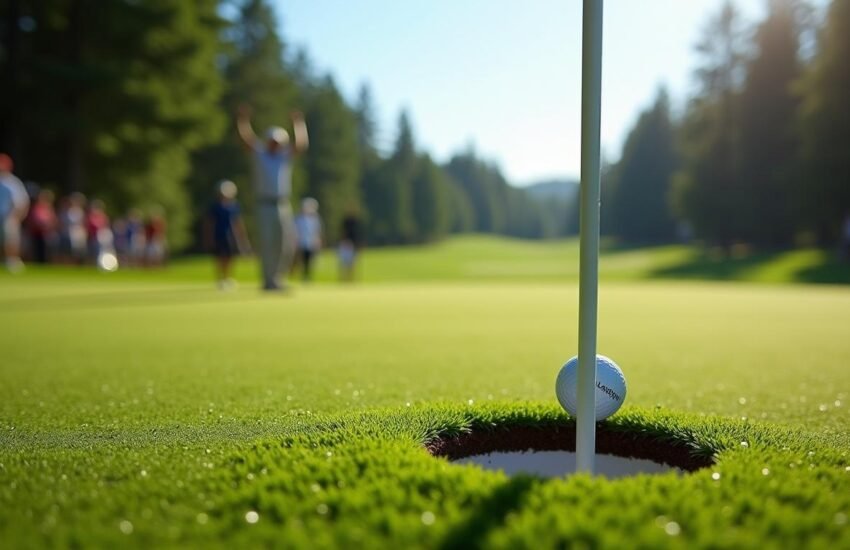Truth About The Average Golf Handicap
Your average golf handicap reveals more than you might expect. Male golfers in the U.S. average 14.2, while women typically score 27.5. Most weekend warriors on the fairway cluster around 13.0-13.9, which represents 5.42% of registered players. Nearly a quarter of players fall between 10.0-13.9. Shooting under 80 consistently might seem like a distant goal, but players can definitely achieve it with practice.
Golf handicap numbers tell an interesting story. Players’ age significantly impacts their performance. Golfers in their 20s and 30s usually maintain handicaps between 10-15. This number rises to 15-20 for players in their 40s and 50s. Elite male players need a handicap of 4.9 or better to rank among the top 10% – a feat achieved by few registered golfers.
Lower handicaps often lead to more eagles, especially when you have custom fitted clubs that match your swing. The coveted plus handicap (below 0.0) belongs to just 1.85% of men and 0.69% of women, making it one of the most impressive achievements in golf.

What is the Average Golf Handicap Today?
The USGA has released some amazing data showing American golfers are getting better at their game. The sport’s popularity keeps growing with 3.35 million golfers tracking their Handicap Index in the US in 2024—that’s a stunning 30% jump since 2020. Let’s tuck into what these numbers mean for players across all skill levels.
Average Handicap in Golf for Men and Women
Recent USGA statistics show men’s average golf handicap sits at 14.2, while women average 28.7. A typical male golfer shoots in the mid-to-high 80s regularly, though this stays well above professional scores. Women’s average handicap points to scores usually in the low 100s.
The distribution tells us even more. Most male golfers fall between 10.0 and 14.9 handicap range, making up 26.72% of players. About 70% of men have handicaps between 5.0 and 19.9. Women cluster most often in the 25.0-29.9 range, which includes about 19% of female golfers.
American male golfers seem to have a slight advantage over their British counterparts, who average 17.38. British women golfers maintain a slightly better average of 28.09 compared to Americans.
How the Average has Changed Over Time
Today’s golf handicaps show remarkable progress from previous decades. In the last 25 years, men’s average USGA handicap improved by almost two full strokes, dropping from 16.3 to 14.4. Women made similar strides, with their average handicap falling from 29.7 in 1991 to 26.1 in 2016.
A 1983 USGA survey found male golfers averaged 17, while females averaged 31.5. Current averages show both genders improved by about three strokes over four decades. One expert compared this improvement to “the average 100 meter dash time for high school and college runners dropping a full second”.
The handicap spectrum’s extremes have changed dramatically too. Back in 1983, 17% of male golfers had handicaps above 25, but now only 8.5% fall into this group. Women’s numbers dropped from 54% above 30 in 1983 to 43% today.
Why these Numbers Matter
These average golf handicap statistics help you chart your own golf trip. They let you see where you stand among other players. Shooting under 80 consistently puts you in the top 25% of all golfers.
Golf welcomes players of all skill levels. The World Handicap System proves handicaps aren’t just for elite competition players—94.5% of the 77 million rounds posted were recreational.
Age-based handicap patterns show typical player progression. Any improvement deserves celebration! Eagles become more likely as your handicap drops, especially with custom-fitted clubs matching your swing style.
Golf’s diversity keeps growing. The average golfer is 43.5 years old (women typically 4.5 years younger), and people of color make up 23% of American golfers—the highest ever. Women now represent a record 26% of players.
These numbers paint a picture of a sport that welcomes everyone, makes the game available, and creates enjoyment for players at every skill level.
Breaking Down the Most Common Handicap Ranges
Golf handicap distributions reveal fascinating patterns about skill levels in the golfing community. The average golf handicap numbers paint an interesting picture of people who play this challenging sport.
Most Frequent Handicap Brackets for Men
Male golfers with registered handicaps tend to cluster in the low-to-mid teens. The most common handicap index range sits between 13.0-13.9, which includes about 95,000 (5.42%) of registered male golfers. The second most popular bracket of 12.0-12.9 comes in really close at 5.41%, with the 14.0-14.9 range right behind at 5.37%.
The numbers show something interesting – about one-fourth (21.16%) of all men with USGA handicaps fall between 10.0-13.9. This grouping shows how players tend to hit certain skill levels and stay there. Male golfers with handicaps under 13.9 can feel good – they play better than half of all registered male players. Players who consistently shoot under 80 perform well above this average!
Most Frequent Handicap Brackets for Women
Women’s handicap numbers tell a different story. Most female players have handicaps between 27.0-27.9, making up 4.07% (around 18,000) of registered female players. Recent numbers show that women’s average handicaps bunch up between 25.0-29.9.
Women need a handicap of 14.9 or better to rank in the top 10% of players. This skill level means getting an eagle or maybe even an albatross becomes more likely rather than just a lucky shot.
What these Ranges Reveal about the Typical Golfer
These handicap numbers give us a good look at your average recreational golfer. Most players stick close to the average handicap for their age and gender. Very few reach elite status – just 1.85% of men and 0.69% of women have a plus handicap (below 0.0). This shows how rare scratch golfers really are.
The data tells us most golfers play for fun rather than serious competition. Men’s and women’s averages differ quite a bit (14.0 vs. 28.0). This gap probably comes from things like driving distance and how often they play.
Many golfers hit certain handicap ranges and stay there. Getting better at this point usually means more practice time or investing in clubs that match their swing style.
Yes, it is clear from these stats that golf remains a sport where regular players aren’t anywhere near pro level – but that’s exactly why most people find it both fun and challenging.

Where Do You Stand? Handicap Percentiles Explained
You might be curious about how your golf game compares to others. Let’s look at the handicap percentiles that shape the golf world and help you see where you stand among other players.
Top 50%: The Mid-level Standard
Getting into the top half of all golfers isn’t as tough as you’d think. Male players who achieve a handicap of 13.9 or lower rank above 50.5% of all men with registered USGA handicaps. The mid-handicap range (10-20) represents where most casual golfers play. Players in this range can shoot under 80 on their good days.
Women’s golf follows different numbers. Female players need a handicap around 27.0-27.9 to reach the median level.
Top 10%: What It Takes to be Elite
The upper levels of amateur golf demand dedication and steady play. Male golfers need a handicap of 4.9 or better to join the top 10%. Women must reach 14.9 or better to enter this select group. Players at this level care less about average scores and focus more on specific improvements.
These elite players show excellent course management skills and usually score in the 70s. Eagles become real possibilities rather than rare events. Players often spend countless hours practicing and use custom fitted clubs to boost their game.
Scratch and Plus Handicaps: How Rare are They?
Scratch (0.0) or plus handicap status stands as the pinnacle of amateur golf achievement. Only 1.85% of men and 0.69% of women reach plus handicaps. This means roughly 35,883 players hold plus handicaps among all registered golfers.
Age patterns show up even at elite levels, with younger players more likely to hit these impressive numbers. A scratch golfer belongs to a truly exclusive club.
Any improvement deserves celebration. These percentiles just give you a clearer picture of where you stand. Professional tour players would rate between +5 to +8, but most serious amateurs should focus on steady progress rather than chasing pro-level scores.
Average Golf Handicap by Age Group
The sort of thing I love about golf handicaps is how they evolve throughout a player’s trip through life. Players’ average handicaps follow predictable patterns as they age, showing an interesting balance between growing expertise and natural physical decline.
Golfers in Their 20s and 30s
Young golfers have clear physical advantages that show up in their average golf handicap. Players in their 20s score the lowest averages around 90 on par 72 courses. Their faster swing speeds and fewer physical limitations contribute to this success. These players benefit from quick recovery times that allow more practice sessions.
The average handicap rises slightly to 15-16 for golfers in their 30s when work and family start competing with golf time. Many dedicated 30-something players still manage to shoot under 80 through raw athleticism and solid fundamentals.
Golfers in Their 40s and 50s
Mid-life players show an average golf handicap of 18-20 in their 40s. This reflects their ongoing balance between experience and declining flexibility. A surprising trend emerges in the 50s age bracket where the average drops slightly to around 91. More available playing time from stable careers and fewer family duties leads to this improvement. Players over 50 make up for reduced distance by focusing on short game skills and scoring eagles through smart play rather than power.
Golfers 60 and Older
Senior golfers maintain impressive handicaps between 15-20 despite physical limitations. Their driving distance naturally decreases to 190-210 yards compared to younger players’ 240+ yards, but experience makes up the difference. Retirement provides plenty of practice time, and custom-fitted clubs help adapt to changing swing dynamics. Senior players often develop exceptional short game skills that younger golfers admire. This proves that course wisdom can outweigh raw power on the golf course.

How to Improve Your Golf Handicap
Lowering your golf handicap needs a methodical approach and steady practice. You might dream of shooting under 80 or want to cut a few strokes off your game. These proven methods will help you track your progress.
Track Your Scores Consistently
Your performance records are the foundations of improving your golf handicap. Numbers tell the truth – golfers who track their stats save about 3 shots over a year. Record total scores along with specific metrics like fairways hit, greens in regulation, and putts per round. This analysis shows where you lose strokes. You’ll spot patterns and weaknesses that weren’t clear before.
Use the GHIN App or Similar Tools
Modern technology makes handicap tracking simple. The official GHIN mobile app from the USGA has become crucial for serious players. Over 2.5 million golfers used it to post more than 80 million scores in 2024. This tool lets you:
- Post scores and monitor your Handicap Index
- Access GPS and course maps during rounds
- Track detailed statistics about your game
- Calculate your Course Handicap automatically
The GHIN app has evolved from a score posting tool to a complete golf companion. Custom fitted clubs combined with informed decisions can speed up your improvement.
Focus on Short Game and Putting
Every improvement in golf handicap deserves celebration! The quickest way to lower your golf handicap by age runs through your short game. Research shows that putting skill substantially affects overall performance. Spend two-thirds of practice time on putting, chipping, and pitching to see immediate score improvements. Strong putting skills can make up for weaknesses in other parts of your game.
Play More Rounds on Rated Courses
Regular play on rated courses increases your chances of getting an eagle. The World Handicap System requires a minimum of 54 holes for your golf handicap calculation. Personal improvement matters more than comparing yourself to average golf handicaps. Different courses with varying challenges build adaptability and course management skills.
Average Golf Handicap Frequently Asked Question
What is Considered a Good Golf Handicap for an Average Player?
For an average male golfer, a handicap between 10-17 is considered good, typically resulting in scores around 90. For women, a handicap in the 25-30 range is considered good for an average player.
How does Age Affect Golf Handicaps?
Golf handicaps tend to follow a U-shaped curve with age. Players in their 20s and 30s often have the lowest handicaps due to physical advantages. Handicaps typically increase slightly in the 40s and 50s, but may improve again for seniors as they have more time to play and develop their short game skills.
What Percentage of Golfers have a Scratch or Plus Handicap?
Scratch (0.0) or plus handicaps are extremely rare. Only about 1.85% of male golfers and 0.69% of female golfers achieve this elite level of play.
How can I Improve My Golf Handicap?
To lower your handicap, focus on consistent score tracking, use tools like the GHIN app, dedicate more practice time to your short game and putting, and play regularly on rated courses. Custom-fitted clubs can also help maximize your potential.
What is the Average Golf Handicap for Men and Women in the United States?
According to recent USGA statistics, the average golf handicap for men in the U.S. is 14.2, while for women it’s 28.7. This suggests that a typical male golfer shoots in the mid-to-high 80s, while the average female golfer scores in the low 100s.
How is a Golf Handicap Calculated?
A golf handicap is calculated based on your recent scores, course rating, and slope rating. The formula considers your best scores from recent rounds (usually the lowest 8 of the last 20), adjusted for course difficulty, to produce a number that reflects your potential playing ability.
What is a Handicap Index and How is it Used?
The Handicap Index is a standardized number that allows golfers to compete fairly on different courses. It’s portable, meaning it can be used at any course with a known slope and course rating to calculate a Course Handicap for that round.
Can Beginners Have a Golf Handicap?
Yes, beginners can establish a golf handicap by submitting scores for as few as 54 holes. As they continue to play and submit more scores, their handicap becomes more accurate and reflective of their playing ability.
What is the Difference Between Gross Score and Net Score in Golf?
Gross score is the total number of strokes taken during a round, while net score is the gross score minus the player’s handicap. Net scoring is commonly used in competitions to level the playing field among golfers of different skill levels.
Why Do Handicaps Vary Between Courses?
Handicaps vary between courses due to differences in difficulty, measured by the course and slope ratings. A golfer’s Course Handicap adjusts the Handicap Index based on these ratings to ensure a fair challenge relative to the course played.


